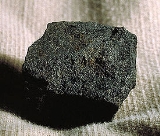
Bituminous coal
Overview
Coal
Coal is a combustible black or brownish-black sedimentary rock usually occurring in rock strata in layers or veins called coal beds or coal seams. The harder forms, such as anthracite coal, can be regarded as metamorphic rock because of later exposure to elevated temperature and pressure...
containing a tarlike substance called bitumen. It is of higher quality than lignite coal
Lignite
Lignite, often referred to as brown coal, or Rosebud coal by Northern Pacific Railroad,is a soft brown fuel with characteristics that put it somewhere between coal and peat...
but of poorer quality than Anthracite. It is usually formed as a result of high pressure on lignite.
Bituminous coal is an organic sedimentary rock formed by diagenetic and sub metamorphic compression of peat
Peat
Peat is an accumulation of partially decayed vegetation matter or histosol. Peat forms in wetland bogs, moors, muskegs, pocosins, mires, and peat swamp forests. Peat is harvested as an important source of fuel in certain parts of the world...
bog material.
Bituminous coal has been compressed and heated so that its primary constituents are maceral
Maceral
A maceral is a component of coal or oil shale. The term 'maceral' in reference to coal is analogous to the use of the term 'mineral' in reference to igneous or metamorphic rocks. Examples of macerals are inertinite, vitrinite and liptinite.- Inertinite :...
s vitrinite
Vitrinite
Vitrinite is one of the primary components of coals and most sedimentary kerogens. Vitrinite is a type of maceral, where "macerals" are organic components of coal analogous to the "minerals" of rocks. Vitrinite has a shiny appearance resembling glass . It is derived from the cell-wall material or...
, exinite
Exinite
Liptinite is an umbrella term used in coal geology, referring to the finely-ground and macerated remains found in coal deposits. It replaced the term Exinite as one of the four categories of kerogen. Liptinites were originally formed by spores, pollen, dinoflagellate cysts, leaf cuticles, and plant...
, and so on.

